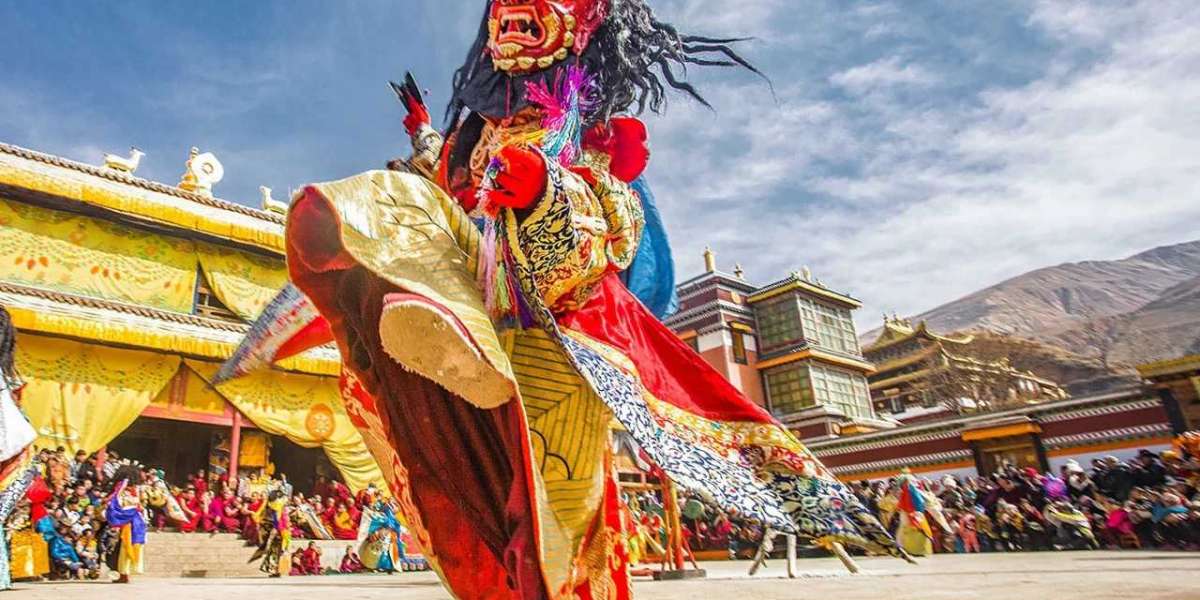Historical Origins
The origins of Cham Dance are deeply rooted in the rich tapestry of Tibetan culture and religion. It is believed that Cham dance was introduced to Tibet in the 7th century, possibly during the reign of King Songtsen Gampo who is said to have invited Indian and Nepalese Buddhist monks to spread the teachings of Buddhism. Over the centuries, these dances evolved to incorporate local folklore, religious narratives, and symbolism reflecting the spiritual journey of Tibetan people.
Cham dance is closely associated with the Nyingma school of Tibetan Buddhism but has been embraced by other schools as well, including Gelug and Kagyu. The dances often represent Buddhist teachings, convey moral messages, and celebrate the victory of good over evil.
The Performance
Cham dances are characterized by their elaborate costumes, energetic movements, and striking masks. Dancers often wear intricate garments that reflect the divine figures or mythical beings they represent during the performance. The masks, often handcrafted from materials like wood and cloth, are painted in vivid colors and adorned with detailed decorations, signifying various deities, protectors, and teachings.
Typically performed by monks or community members trained in the art form, Cham dance involves a combination of group choreography and solo performances. The dancers rhythmically move, often accompanied by traditional Tibetan music, which includes instruments such as drums, bells, and flutes. The performances can be quite lengthy, sometimes lasting several hours, as they narrate complex stories related to Tibetan Buddhism.
Symbolism and Themes
Cham dances are imbued with deep symbolism, each step, movement, and gesture carrying significant meaning. Common themes include:
Spiritual Symbolism: Dances often represent the struggle between enlightenment and ignorance, embodying the path toward liberation from the cycle of rebirth.
Buddha Deities: Many dances depict various Buddhas, bodhisattvas, and protectors, showcasing their qualities and teachings in an engaging manner.
Moral Lessons: Some performances recount historical tales or parables that impart moral teachings, emphasizing values such as compassion, patience, and the importance of dharma (cosmic law and order).
Major Cham Festivals
While Cham dances can be seen at various religious events, some of the most notable performances occur during significant festivals. The most recognized include:
Losar: The Tibetan New Year, during which communities celebrate with rituals, feasts, and performances. Cham dances during Losar symbolize the expulsion of negative energy and the welcoming of positive blessings.
Monlam Prayer Festival: Held in Lhasa, this festival involves extensive ceremonies, including Cham dances performed by monks from various monasteries.
Other Regional Festivals: Different regions in Tibet and the Tibetan diaspora may host their own Cham performances during local celebrations, maintaining the tradition while infusing it with local customs.
Cultural Preservation and Challenges
The preservation of Cham dance is crucial in maintaining Tibetan culture, especially in light of political and social challenges faced by the Tibetan community. Many practitioners and communities are actively involved in initiatives to teach and promote this art form, both within Tibet and among Tibetan communities abroad.
In addition to traditional performances, there has been a growing interest in Cham dance among younger generations, who are exploring its relevance in contemporary contexts. Workshops, cultural exchanges, and performances outside of Tibet have contributed to a broader appreciation and understanding of this unique art form.
Conclusion
Tibetan Cham dance is a remarkable cultural heritage that embodies the spiritual depth and artistic expression of Tibetan Buddhism. Through its vibrant performances, intricate costumes, and profound symbolism, Cham dance continues to speak to the heart of Tibetan identity, forging connections across generations and communities. As Tibetan culture faces the challenges of modernization and globalization, the preservation and appreciation of Cham dance remain vital in honoring the rich tapestry of Tibetan traditions and beliefs. In celebrating Cham dance, we also celebrate resilience, spirituality, and the enduring power of storytelling in preserving cultural heritage.




